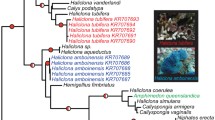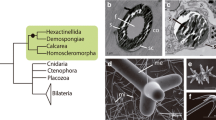Abstract
Silicatein genes are involved in spicule formation in demosponges (Demospongiae: Porifera). However, numerous attempts to isolate silicatein genes from glass sponges (Hexactinellida: Porifera) resulted in a limited success. In the present investigation, we performed analysis of potential silicatein/cathepsin transcripts in three different species of glass sponges (Pheronema raphanus, Aulosaccus schulzei, and Bathydorus levis). In total, 472 clones of such transcripts have been analyzed. Most of them represent cathepsin transcripts and only three clones have been found to represent transcripts, which can be related to silicateins. Silicatein transcripts were identified in A. schulzei (Hexactinellida; Lyssacinosida; Rosselidae), and the corresponding gene was called AuSil-Hexa. Expression of AuSil-Hexa in A. schulzei was confirmed by real-time PCR. Comparative sequence analysis indicates high sequence identity of the A. schulzei silicatein with demosponge silicateins described previously. A phylogenetic analysis indicates that the AuSil-Hexa protein belongs to silicateins. However, the AuSil-Hexa protein contains a catalytic cysteine instead of the conventional serine.



Similar content being viewed by others
References
Abascal F, Zardoya R, Posada D (2005) ProtTest: Selection of best-fit models of protein evolution. Bioinformatics 21:2104–2105
Altschul SF, Madden TL, Schaffer AA, Zhang J, Zhang Z, Miller W, Lipman DJ (1997) Gapped BLAST and PSI-BLAST: a new generation of protein database search programs. Nucleic Acids Res 25:3389–3402
Berti P, Storer A (1995) Alignment/phylogeny of the papain superfamily of cysteine proteases. J Mol Biol 246:273–283
Brutchey RL, Morse DE (2008) Silicatein and the translation of its molecular mechanism of biosilicification into low temperature nanomaterial synthesis. Chem Rev 108:4915–4934
Chomczynski P, Sacchi N (1987) Single-step method of RNA isolation by acid guanidinium thiocyanate-phenol-chloroform extraction. Anal Biochem 162:156–159
Dayton PK (1979) Observations of growth, dispersal and population dynamics of some sponges in McMurdo Sound, Antarctica. In: Lévi C and Boury-Esnault N (eds.) Colloques internationaux du C.N.R.S. 291. Biologie des spongiaires. E´ ditions du Centre National de la Recherche Scientifique, Paris. pp. 271–282
Ehrlich H, Worch H (2007) Collagen: a huge matrix in glass sponge flexible spicules of the meter-long Hyalonema sieboldi. In: Bäuerlein E (ed) Handbook of biomineralization. Wiley, Weinheim, pp 23–41
Ehrlich H, Ereskovsky A, Drozdov A, Krylova D, Hanke T, Meissner H, Heinemann S, Worch H (2006) A modern approach to demineralisation of spicules in the glass sponges (Hexactinellida: Porifera) for the purpose of extraction and examination of the protein matrix. Russ J Mar Biol 32:186–193
Ehrlich H, Krautter M, Hanke T, Simon P, Knieb C, Heinemann S, Worch H (2007) First evidence of the presence of chitin in skeletons of marine sponges. Part II. Glass sponges (Hexactinellida: Porifera). J Exp Zool (Mol Dev Evol) 308B:473–483
Ehrlich H, Deutzmann R, Brunner E, Cappellini E, Koon H, Solazzo C, Yang Y, Ashford D, Thomas-Oates J, Lubeck M, Baessmann C, Langrock T, Hoffmann R, Wörheide G, Reitner J, Simon P, Tsurkan M, Ereskovsky AV, Kurek D, Bazhenov VV, Hunoldt S, Mertig M, Vyalikh DV, Molodtsov SL, Kummer K, Worch H, Smetacek V, Collins MJ (2010) Mineralization of the metre-long biosilica structures of glass sponges is templated on hydroxylated collagen. Nat Chem 12:1084–1088
Fairhead M, Johnson K, Kowatz T, McMahon S, Carter L, Oke M, Liu H, Naismith J, van der Walle C (2008) Crystal structure and silica condensing activities of silicatein alpha-cathepsin L chimeras. Chem Commun (Camb) 15:1765–1767
Gatti S (2002) High Antarctic carbon and silicon cycling—how much do sponges contribute? VI International Sponge Conference. In: Book of Abstracts, Bollettino dei Musei Instituti Biologici, vol. 66–67 University of Genoa. p. 76
Guindon S, Gascuel O (2003) A simple, fast, and accurate algorithm to estimate large phylogenies by maximum likelihood. Syst Biol 52:696–704
Heinemann S, Ehrlich H, Knieb C, Hanke T (2007) Biomimetically inspired hybrid materials based on silicified collagen. Int J Mat Res 98:603–608
Katoh K, Misawa K, Kuma K, Miyata T (2002) MAFFT: a novel method for rapid multiple sequence alignment based on fast Fourier transform. Nucleic Acids Res 30:3059–3066
Kozhemyako VB, Veremeichik GN, Shkryl YN, Kovalchuk SN, Krasokhin VB, Rasskazov VA, Zhuravlev YN, Bulgakov VP, Kulchin YN (2010) Silicatein genes in spicule-forming and non-spicule-forming Pacific demosponges. Mar Biotechnol 12:403–409
Krasko A, Lorenz B, Batel R, Schröder HC, Müller IM, Müller WEG (2000) Expression of silicatein and collagen genes in the marine sponge Suberites domuncula is controlled by silicate and myotrophin. Eur J Biochem 267:4878–4887
Krautter M (2002) Fossil Hexactinellida: an overview. In: Hooper JNA, van Soest RWM (eds) Systema Porifera: a guide to the classification of sponges. Plenum, New York, pp 1211–1223
Matz M, Shagin D, Bogdanova O, Lukyanov S, Diatchenko L, Chenchik A (1999) Amplification of cDNA ends based on template-switching effect and step-out PCR. Nucleic Acids Res 2:1558–1560
Mohri K, Nakatsukasa M, Masuda Y, Agata K, Funayama N (2008) Toward understanding the morphogenesis of siliceous spicules in freshwater sponge: differential mRNA expression of spicule-type-specific silicatein genes in Ephydatia fluviatilis. Dev Dyn 237:3024–3039
Müller WEG, Boreiko A, Wang X, Belikov SI, Weins M, Grebenjuk VA, Schloßmacher U, Schröder HC (2007) Silicateins, the major biosilica forming enzymes present in demosponges: protein analysis and phylogenetic relationship. Gene 395:62–71
Müller WEG, Boreiko A, Schloßmacher U, Wang X, Eckert C, Kropf K, Li J, Schröder HC (2008a) Identification of a silicatein(-related) protease in the giant spicules of the deep-sea hexactinellid Monorhaphis chuni. J Exp Biol 211:300–309
Müller WEG, Wang X, Kropf K, Boreiko A, Schloßmacher U, Brandt D, Schröder HC, Wiens M (2008b) Silicatein expression in the hexactinellid Crateromorpha meyeri: the lead marker gene restricted to siliceous sponges. Cell Tissue Res 333:339–351
Ronquist F, Huelsenbeck JP (2003) MRBAYES 3: Bayesian phylogenetic inference under mixed models. Bioinformatics 19:1572–1574
Schröder H, Perović-Ottstadt S, Wiens M, Batel R, Müller IM, Müller WEG (2004) Differentiation capacity of epithelial cells in the sponge Suberites domuncula. Cell Tissue Res 316:271–280
Schröder H, Perović-Ottstadt S, Grebenjuk VA, Engel S, Müller IM, Müller WEG (2005) Biosilica formation in spicules of the sponge Suberites domuncula: synchronous expression of a gene cluster. Genomics 85:666–678
Schröder H, Wang X, Tremel W, Ushijima H, Müller W (2008) Biofabrication of biosilica-glass by living organisms. Nat Prod Rep 25:455–474
Shimizu K, Cha J, Stucky G, Morse D (1998) Silicatein α: cathepsin L-like protein in sponge biosilica. Proc Natl Acad Sci USA 95:6234–6238
Swofford DL (2002) PAUP* Phylogenetic analysis using parsimony. Version 4.0b10. Sinauer Associates, Massachusetts
Uriz M-J, Turon X, Becerro MA, Agell G (2003) Siliceous spicules and skeleton frameworks in sponges: origin, diversity, ultrastructural patterns, and biological functions. Microsc Res Tech 62:279–299
Wiens M, Belikov SI, Kaluzhnaya OV, Krasko A, Schröder HC, Perović-Ottstadt S, Müller WEG (2006) Molecular control of serial module formation along the apical-basal axis in the sponge Lubomirskia baicalensis: silicateins, mannose-binding lectin and mago nashi. Dev Genes Evol 216:229–242
Acknowledgments
This work was supported by a grant from the Grant Program “Principles of Basic Investigations of Nanotechnologies and Nanomaterials” of the Russian Academy of Sciences.
Author information
Authors and Affiliations
Corresponding author
Electronic Supplementary Materials
Below is the link to the electronic supplementary material.
Supplemental Figure 1
The multiple sequence alignment of poriferan silicateins and cathepsins. (DOC 8,323 kb)
Supplemental Figure 2
A phylogram of sponge silicateins and cathepsins resulting from the Bayesian analysis (WAG + I + G substitution model). Silicateins are marked by different colors: subclade I (blue), subclade II (purple), and subclade III (green). The scale bar indicates the number of changes per site. (DOC 28 kb)
Supplemental Figure 3
A phylogram of sponge silicateins and cathepsins resulting from the maximum likelihood analysis (WAG + I + G substitution model). Silicateins are marked by different colors: subclade I (blue), subclade II (purple), and subclade III (green). The scale bar indicates the number of changes per site. (DOC 28 kb)
Supplemental Figure 4
A phylogram of sponge silicateins and cathepsins resulting from the maximum parsimony analysis using a stepmatrix derived from the Blosum62 amino acid transition matrix. Silicateins are marked by different colors: subclade I (blue), subclade II (purple), and subclade III (green). The scale bar indicates the number of changes. (DOC 28 kb)
Rights and permissions
About this article
Cite this article
Veremeichik, G.N., Shkryl, Y.N., Bulgakov, V.P. et al. Occurrence of a Silicatein Gene in Glass Sponges (Hexactinellida: Porifera). Mar Biotechnol 13, 810–819 (2011). https://doi.org/10.1007/s10126-010-9343-6
Received:
Accepted:
Published:
Issue Date:
DOI: https://doi.org/10.1007/s10126-010-9343-6




